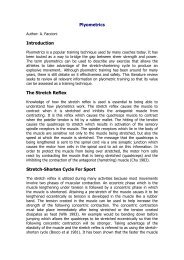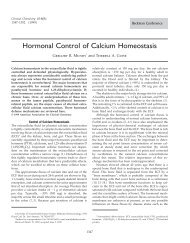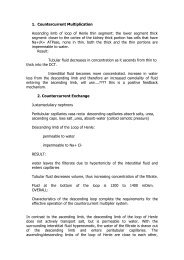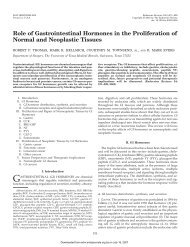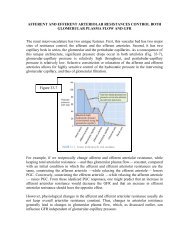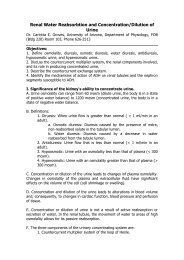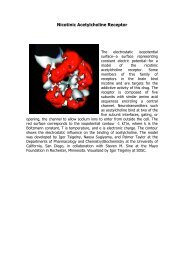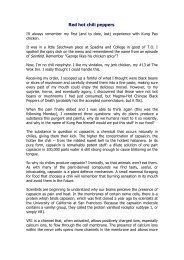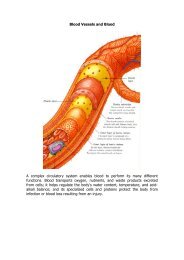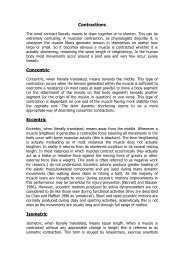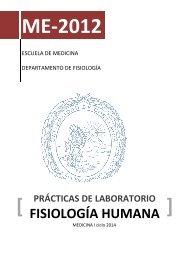Caramelo C et al. <strong>Anemia</strong> <strong>in</strong> <strong>Heart</strong> <strong>Failure</strong>donation, as perioperative adjuvant therapy and <strong>in</strong> HF. 52In CRD, a condition <strong>in</strong> which the experience is moreextensive, the standard doses for <strong>in</strong>itial EPO therapy are400 U/kg bw/week and 15-200 U/kg bw/week,adm<strong>in</strong>istered <strong>in</strong>travenously and subcutaneously,respectively, divided <strong>in</strong>to 1 to 3 doses per week. 84However, there is less <strong>in</strong>formation on the doses to beadm<strong>in</strong>istered <strong>in</strong> HF. Thus, regimens similar to those tested<strong>in</strong> CRD are be<strong>in</strong>g used, and will have to be verified overthe course of time.IRON THERAPYSome authors susta<strong>in</strong> that it is practically obligatoryto add <strong>in</strong>travenous iron therapy to treatment with EPO 9,29to prevent possible iron deficiency secondary to the<strong>in</strong>crease <strong>in</strong> hematopoiesis. The additive effect of thecomb<strong>in</strong>ation of iron and EPO may not be achieved withoral iron. 85,86 However, there is a lack of data to enableus to predict which patients will fail to absorb oral iron,and it is to be hoped that hepcid<strong>in</strong> measurements willhelp to resolve this question. The exist<strong>in</strong>g <strong>in</strong>travenousiron preparations, iron gluconate (Ferrlecit, Rhone-Poulenc, 62.5 mg elemental iron), and iron sucrose(Venofer, Uriach, 100 mg elemental iron), have practicallyno collateral effects if used <strong>in</strong> reasonable doses, forexample, 1 vial a week, <strong>in</strong> cycles of 6 to 9 vials, depend<strong>in</strong>gon the ferrit<strong>in</strong> levels. These doses that we mention aremore conservative than others that have been employed,but they take <strong>in</strong>to account the possibility of <strong>in</strong>duction ofoxidative effects due to the adm<strong>in</strong>istration of largequantities of iron via a nonphysiological route, the<strong>in</strong>travenous route. As a comparative datum for dos<strong>in</strong>g, ablood transfusion supplies approximately 250 mg ofelemental iron, which eventually becomes part of theiron <strong>in</strong> the organism due to the gradual destruction of thetransfused red blood cells.On the other hand, certa<strong>in</strong> recent data <strong>in</strong>dicate that,at least <strong>in</strong> some patients, iron deficiency is the majorpathogenic factor <strong>in</strong> anemia. In these cases, adjuvanttreatment with EPO would not be necessary, as ispo<strong>in</strong>ted out <strong>in</strong> recent communications, whichdemonstrate improvements <strong>in</strong> anemia with iron therapyalone, 87 and <strong>in</strong> prelim<strong>in</strong>ary results from cl<strong>in</strong>ical studiespend<strong>in</strong>g publication or still underway, such as FERRIC-HF and IRON-HF. 88,89 The possible iron deficiency,absolute or relative, can become more marked due toother additional factors, such as losses secondary toantiplatelet/anticoagulant therapy and aspir<strong>in</strong>-<strong>in</strong>ducedgastritis. 7,10,20 Moreover, right HF can favor deficientabsorption or nutritional deficiencies <strong>in</strong>volv<strong>in</strong>g elementsnecessary for erythroid maturation, such as vitam<strong>in</strong>B 12and folic acid, and iron itself. 11 There are no recentstudies on the prevalence of vitam<strong>in</strong> deficiencies <strong>in</strong><strong>in</strong>dividuals with HF, but the current appraisal is thatthese pathogenic elements of anemia are of limitedimportance <strong>in</strong> this context.ERYTHROPOIETIN CAN IMPROVE HEARTFAILURE NOT ONLY BY CORRECTINGANEMIAErythropoiet<strong>in</strong> has cytoprotective effects on cardiacendothelium 74 and muscle. The EPO-R is present aboveall dur<strong>in</strong>g the fetal period, although it is also found <strong>in</strong>smaller amounts <strong>in</strong> the adult heart. 83 On this basis,treatment with EPO could prevent cardiomyocyteapoptosis and stimulate the production of myocardialblood vessels. In vitro and animal studies <strong>in</strong>dicate thatEPO is capable of reduc<strong>in</strong>g the apoptotic cell deathassociated with coronary ischemia/reperfusion. 90 Onehighly <strong>in</strong>terest<strong>in</strong>g possibility is that EPO stimulatesneovascularization, <strong>in</strong> part, because it <strong>in</strong>creases themobilization of endothelial progenitor cells from thebone marrow to the blood. 90CURRENT PERSPECTIVESAt this po<strong>in</strong>t, the issue can be summarized by say<strong>in</strong>gthat multiple partial data <strong>in</strong>dicate that the correction ofanemia provides tangible benefits <strong>in</strong> the natural historyand symptoms of heart failure, but that it is necessary toestablish the limits of these benefits and developsufficiently complex models for the application ofdiagnostic methods and treatment.The extensive material available justifies undertak<strong>in</strong>gtherapeutic efforts to correct anemia <strong>in</strong> HF. However, thedegree of uncerta<strong>in</strong>ty <strong>in</strong> fundamental aspects, bothpathogenic and those concern<strong>in</strong>g the therapeutic targets,is still significant. It is clear, as Roig stressed <strong>in</strong> this samejournal, 11 that one relevant aspect of anemia <strong>in</strong> HF is itscondition as a marker of severity. While prelim<strong>in</strong>arystudies <strong>in</strong>dicate that the treatment of anemia with ESAhas potentially beneficial effects, the available <strong>in</strong>formationdoes not enable us to reach more def<strong>in</strong>itive conclusions.In recent months, 2 large studies on anemia of CRDhave been published 91,92 ; the result<strong>in</strong>g data not only donot encourage the restoration of normal hemoglob<strong>in</strong>levels (13 g/dL), but <strong>in</strong>dicate that, despite the improvement<strong>in</strong> the functional class, there may be a greater number ofcardiovascular complications <strong>in</strong> patients <strong>in</strong> whom thecorrection of anemia is more complete. Other reportshad demonstrated that the tendency toward thedevelopment of left ventricular hypertrophy is not reversedwith the achievement of hemoglob<strong>in</strong> over 12 g/dL. Toillustrate the degree of controversy <strong>in</strong>volved, these datado not support the elevation of the treatment thresholdadvocated by the NKF <strong>in</strong> its 2006 guidel<strong>in</strong>es 15 and haveled to the proposal for the new version that we mentionedabove.With regard to issues specifically related to HF, at theEuropean Society of Cardiology meet<strong>in</strong>g held <strong>in</strong> 2006,data from another 2 double-bl<strong>in</strong>d, randomized, placebocontrolledstudies focus<strong>in</strong>g on the treatment of anemiaof HF with darbepoet<strong>in</strong> were provided. 93 All theRev Esp Cardiol. 2007;60(8):848-60 857
Caramelo C et al. <strong>Anemia</strong> <strong>in</strong> <strong>Heart</strong> <strong>Failure</strong>participants had an ejection fraction of 40% or less anda hemoglob<strong>in</strong> level of 9-12.5 g/dL, and HF had to havebeen diagnosed at least 3 months earlier. When the475 patients were analyzed as a whole, the <strong>in</strong>dividualswho had received darbepoet<strong>in</strong> alfa exhibited a significant<strong>in</strong>crease <strong>in</strong> their hemoglob<strong>in</strong> levels. However, while theydid not experience more adverse events than the placebogroup, they did not show a significant improvement <strong>in</strong>the 3 parameters for symptom evaluation (NYHAfunctional class, patient global assessment and theM<strong>in</strong>nesota Liv<strong>in</strong>g with <strong>Heart</strong> <strong>Failure</strong> Questionnaire).These results provide data to establish the limit toimprovement that can be expected with the treatment ofanemia.Together, these studies constitute a call to order toprevent us from overrat<strong>in</strong>g the positive role of thetreatments for anemia or, more exactly, support the needto improve the diagnostic accuracy and the correct choiceof the therapeutic tools. In summary, we can concludethat the correction of values <strong>in</strong>dicative of severe anemia(hemoglob<strong>in</strong> less than 10 g/dL) is beneficial, but that theachievement of values that surpass that level may notoffer additional advantages. The results of the largemulticenter studies that are currently be<strong>in</strong>g performedor are gett<strong>in</strong>g underway will probably help us to clarifyimportant practical aspects that have yet to be resolved.The largest of these studies (RED-HF) is now be<strong>in</strong>gcarried out. Its objective is to evaluate the effects ofdarbepoet<strong>in</strong> alfa on the morbidity and mortality rates <strong>in</strong>3400 patients with HF us<strong>in</strong>g a randomized, placebocontrolleddesign, which we hope will make it possibleto consolidate evidence-based treatment strategies.REFERENCES1. Szachniewicz J, Petruk-Kowalczyk J, Majda J, Kaczmarek A,Reczuch K, Kalra PR, et al. <strong>Anemia</strong> as an <strong>in</strong>dependent predictor ofpoor outcome <strong>in</strong> patients with chronic heart failure. Int J Cardiol.2003;90:303-8.2. Hunt SA, Baker DW, Ch<strong>in</strong> MH, C<strong>in</strong>quegrani MP, Feldman AM,Francis GS, et al. ACC/AHA guidel<strong>in</strong>es for the evaluation andmanagement of chronic heart failure: Executive Summary.Circulation. 2001;104:2996-3007.3. Hunt SA. ACC/AHA guidel<strong>in</strong>es for the evaluation and managementof chronic heart failure. J Am Coll Cardiol. 2005;46:e1-82.4. Crespo Leiro MG, Jiménez-Navarro M, Cabrera F, Sánchez PL.Insuficiencia cardiaca en el año 2006. Rev Esp Cardiol. 2007;60: 58-67.5. Swedberg K, Cleland J, Dargie H, Drexler H, Follath F, KomajdaM, et al. Guías de práctica clínica sobre el diagnóstico y tratamientode la <strong>in</strong>suficiencia cardiaca crónica. Versión resumida (actualización2005). Rev Esp Cardiol. 2005;58:1062-92.6. Komajda M. Prevalence of anemia <strong>in</strong> patients with chronic heartfailure and their cl<strong>in</strong>ical characteristics. J Card Fail. 2004;10:S1-4.7. Pascual Hernández D, Serrano Sánchez JA, García Robles JA, MuñozAguilera R, Prieto Arévalo R. <strong>Anemia</strong> e <strong>in</strong>suficiencia cardiaca.Manual de <strong>in</strong>suficiencia cardiaca (diagnóstico y tratamiento de unapatología en expansión). Madrid: Just <strong>in</strong> Time; 2004. p. 70-3.8. Cohn JN, Tognoni G. A randomized trial of the angiotens<strong>in</strong>-receptorblocker valsartan <strong>in</strong> chronic heart failure. N Engl J Med. 2001;345:1667-75.9. Silverberg DS, Wexler D, Blum M, Keren G, Sheps D, LeibovitchE, et al. The Use of subcutaneous erythropoiet<strong>in</strong> and <strong>in</strong>travenousiron for the treatment of the anemia of severe, resistant congestiveheart failure improves cardiac and renal function and functionalcardiac class, and markedly reduces hospitalizations.J Am Coll Cardiol. 2000;35:1737-44.10. Ezekowitz A, McAlister FA, Armstrong PW. <strong>Anemia</strong> is common<strong>in</strong> heart failure and is associated with poor outcomes: <strong>in</strong>sights froma cohort of 12 065 patients with new-onset heart failure. Circulation.2003;107:223-5.11. Roig E. La anemia en la <strong>in</strong>suficiencia cardiaca. ¿Es un marcador degravedad o un objetivo terapéutico? Rev Esp Cardiol. 2005;58:10-2.12. Wisniacki N, Aimson P, Lyle M. Is anemia a cause of heart failure<strong>in</strong> the elderly? <strong>Heart</strong>. 2001;85 Suppl 1:P4.13. Horwich TB, Fonarow GC, Hamilton MA, MacLellan WR,Borenste<strong>in</strong> J. <strong>Anemia</strong> Is associated with worse symptoms, greaterimpairment <strong>in</strong> functional capacity and a significant <strong>in</strong>crease <strong>in</strong>mortality <strong>in</strong> patients with advanced heart failure. J Am Coll Cardiol.2002;39:1780–6.14. NKF-K/DOQI Cl<strong>in</strong>ical practice guidel<strong>in</strong>es for anemia of chronickidney disease: update 2000. Am J Kidney Dis. 2001;37(1 Supl1):S182-238.15. Cl<strong>in</strong>ical Practice Guidel<strong>in</strong>es and Cl<strong>in</strong>ical Practice Recommendationsfor <strong>Anemia</strong> <strong>in</strong> Chronic Kidney Disease <strong>in</strong> adults. CPG and CPR 2.1.Hb range. Am J Kidney Dis. 2006;47(5 Suppl 3):S16-85. Availablefrom: www.kidney.org/professionals/KDOQI/guidel<strong>in</strong>es_anemia/cpr21.htm16. Cleland JG, Swedberg K, Follath F, Komajda M, Cohen-Solal A,Aguilar JC, et al. Study Group on Diagnosis of the Work<strong>in</strong>g Groupon <strong>Heart</strong> <strong>Failure</strong> of the European Society of Cardiology. The Euro<strong>Heart</strong><strong>Failure</strong> survey programme- a survey on the quality of care amongpatients with heart failure <strong>in</strong> Europe. Part 1: patient characteristicsand diagnosis. Eur <strong>Heart</strong> J. 2003;24:442-63.17. Chatterjee B, Nydegger UE, Mohacsi P. Serum erythropoiet<strong>in</strong> <strong>in</strong>heart failure patients treated with ACE-<strong>in</strong>hibitors or AT(1) antagonists.Eur J <strong>Heart</strong> Fail. 2000;2:393-8.18. Anand IS, Chandrashekhar Y, Ferrari R, Poole-Wilson PA, HarrisPC. <strong>Pathogenesis</strong> of oedema <strong>in</strong> chronic anaemia: studies of bodywater and sodium, renal function, haemodynamics and plasmahormones. Br <strong>Heart</strong> J. 1993;70:357-62.19. Androne AS, Katz SD, Lund L, LaManca J, Hudaihed A, HryniewiczK, et al. Hemodilution is common <strong>in</strong> patients with advanced heartfailure. Circulation. 2003;107:226-9.20. Okonko BS, Anker SD. <strong>Anemia</strong> <strong>in</strong> chronic heart failure: pathogeneticmechanisms. J Cardiac <strong>Failure</strong>. 2004;10 Suppl S:5-9.21. Calvillo L, Lat<strong>in</strong>i R, Kajstura J, Leri A, Anversa P, Ghezzi P, et al.Recomb<strong>in</strong>ant human erythropoiet<strong>in</strong> protects the miocardium fromischemia-perfusion <strong>in</strong>jury and promotes beneficial modell<strong>in</strong>g. ProcNatl Acad Sci USA. 2003;100:4802-6.22. Silverberg DS, Wexler D, Ia<strong>in</strong>a A. The role of anemia <strong>in</strong> theprogression of congestive heart failure. Is there a place forerythropoiet<strong>in</strong> and <strong>in</strong>travenous iron? J Nephrol. 2004;17:749-61.23. Weiss G, Goodnough LT. <strong>Anemia</strong> of chronic disease. N Engl J Med.2005;352:1011-23.24. Nanas JN, Matsouka C, Karageorgopoulos D, Leonti A, TsolakisE, Drakos SG, et al. Etiology of anemia <strong>in</strong> patients with advancedheart failure. J Am Coll Cardiol. 2006 19;48:2485-9.25. Gil P, Justo S, Castilla MA, Criado C, Caramelo C. Cardio-renal<strong>in</strong>sufficiency: the search for management strategies. Curr Op<strong>in</strong>Nephrol Hypertens. 2005;14:442-7.26. Caramelo C, Gil P. Insuficiencia comb<strong>in</strong>ada cardiorrenal: una claveevolutiva y terapéutica en el fallo cardíaco. Rev Esp Cardiol.2006;59:87-90.27. Grigorian Shamagian L, Varela Roman A, Pedreira Pérez M, GómezOtero I, Virgos Lamela A, González-Juanatey JR. El fracaso renales un factor de riesgo <strong>in</strong>dependiente en pacientes hospitalizados por<strong>in</strong>suficiencia cardiaca y se asocia con un peor perfil de riesgocardiovascular. Rev Esp Cardiol. 2006;59:99-108.858 Rev Esp Cardiol. 2007;60(8):848-60



